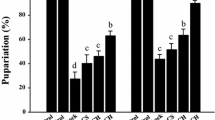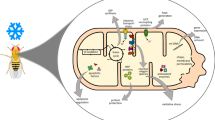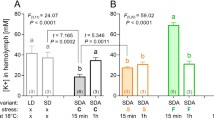Abstract
Apoptosis plays important roles in the selective elimination of sub-lethally damaged cells due to various environmental stresses. The rapid cold-hardening (RCH) response protects insects from the otherwise lethal consequences of injury due to cold-shock. We recently demonstrated that cold shock induces apoptotic cell death in insects and that RCH functions to specifically block cold-shock-induced apoptosis. In the present study we used isolated fat body, midgut, muscle, and Malpighian tubules from adult flesh flies Sarcophaga crassipalpis to test the following hypotheses: (1) cold-induced apoptosis varies among different tissues and (2) RCH blocks the apoptotic pathway by preventing the activation of pro-caspases. Cold-shock induced substantial amounts of apoptotic cell death that matched with tissue damage as determined using vital dyes. RCH treatment significantly reduced apoptotic cell death in all tested tissues. Caspase-3 (executioner) activity was 2–3 times higher in the cold- and heat-shocked groups than in control and RCH groups. Likewise, the activity of caspase-9 (initiator) showed a similar trend as for caspase-3 in all tissues but midgut. In addition, cold-shock and heat-shock treatments also increased caspase-2 activity 2–3 folds in both soluble and membrane fractions of fat body and muscle extracts compared to controls.






Similar content being viewed by others
References
Lee RE, Chen C-P, Denlinger DL (1987) A rapid cold-hardening process in insects. Science 238:1415–1417
Lee RE, Denlinger DL (2010) Rapid cold-hardening: ecological significance and underpinning mechanisms. In: Denlinger DL, Lee RE (eds) Low temperature biology of insects. Cambridge University Press, Cambridge, pp 35–58
Broufas GD, Koveos DS (2001) Cold hardiness characteristics in a strain of the predatory mite Euseius (Amblyseius) finlandicus (Acari: Phytoseiidae) from Northern Greece. Ann Entomol Soc Am 94:82–90
Shreve SM, Kelty JD, Lee RE (2004) Preservation of reproductive behaviors during modest cooling: rapid cold-hardening fine-tunes organismal response. J Exp Biol 207:1797–1802
Kelty J (2007) Rapid cold-hardening of Drosophila melanogaster in a field setting. Physiol Entomol 32:343–350
Overgaard J, Sorensen JG, Petersen SO, Loeschcke V, Holmstrup M (2005) Changes in membrane liquid composition following rapid cold hardening in Drosophila melanogaster. J Insect Physiol 51:1173–1182
Michaud MR, Denlinger DL (2006) Oleic acid is elevated in cell membranes during rapid cold-hardening and pupal diapause in the flesh fly, Sarcophaga crassipalpis. J Insect Physiol 52:1073–1082
Shreve SM, Yi S-X, Lee RE (2007) Increase dietary cholesterol enhances cold tolerance in Drosophila melanogaster. Cryo Lett 28:33–37
Lee RE, Damodaran K, Yi S-X, Lorigan GA (2006) Rapid cold-hardening increases membrane fluidity and cold tolerance of insect cells. Cryobiology 52:459–463
Teets NM, Elnitsky MA, Benoit JB, Lopez-Martinez G, Denlinger DL, Lee RE (2008) Rapid cold-hardening in larvae of the Antarctic midge Belgica antarctica: cellular cold-sensing and a role for calcium. Am J Physiol Regul Integr Comp Physiol 294:R1938–R1946
Yi S-X, Moore CW, Lee RE (2007) Rapid cold-hardening protects Drosophila melanogaster from cold-induced apoptosis. Apoptosis 12:1183–1193
Steller H (1995) Mechanisms and genes of cellular suicide. Science 267:1445–1449
Vaux DL, Korsmeyer SJ (1999) Cell death in development. Cell 96:245–254
Fuller B (2003) Gene expression in response to low temperatures in mammalian cells: a review of current ideas. Cryo Lett 24:95–102
Pérez-Garijo A, Martin FA, Morata G (2004) Caspase inhibition during apoptosis causes abnormal signaling and development aberrations in Drosophila. Development 131:5591–5598
Kerr JF, Wyllie AH, Currie AR (1972) Apoptosis: a basic biological phenomenon with wide-ranging implications in tissue kinetics. Br J Cancer 26:239–257
Philchencov AA (2003) Caspases as regulators of apoptosis and other cell functions. Biochem 68:365–376
Take H, Andersen Ø (2007) Caspases and apoptosis in fish. J Fish Biol 71(Suppl C):326–349
Cohen GM (1997) Caspases: the executioners of apoptosis. Biochem J 326:1–16
Fischer H, Rossiter H, Ghannadan M, Jaeger K, Barresi C, Declercq W, Tschachler E, Eckhart L (2005) Caspase-14 but not caspase-3 is processed during the development of fetal mouse epidermis. Differentiation 73:406–413
Samali A, Cai J, Zhivotovsky B, Jones DP, Orrenius S (1999) Presence of a pre-apoptotic complex of pro-caspase-3, Hsp 60, and Hsp10 in the mitochondrial fraction of Jurkat cells. EMBO J 18:2040–2048
Talanian RV, Quinlan C, Trautz S, Hackett MC, Mankovich JA, Banach D, Ghayur T, Brady KD, Wong WW (1997) Substrate specificities of caspase family proteases. J Biol Chem 272:9677–9682
Lee RE, Denlinger DL (1985) Cold tolerance in diapausing and non-diapausing stages of the flesh fly, Sarcophaga crassipalpis. Physiol Entomol 10:309–315
Yi S-X, Lee RE (2003) Detecting freeze injury and seasonal cold-hardening of cells and tissues in the gall fly larvae, Eurosta solidaginis (Diptera: Tephritidae) using fluorescent vital dyes. J Insect Physiol 49:999–1004
Yi S-X, Lee RE (2004) In vivo and in vitro rapid cold-hardening protects cells from cold-shock injury in the flesh fly. J Comp Physiol B 174:611–615
Gavrieli Y, Sherman Y, Ben-Sasson SA (1992) Identification of programmed cell death in situ via specific labeling of nuclear DNA fragmentation. J Cell Biol 119:493–501
McCall K, Steller H (1998) Requirement for DCP-1 caspase during Drosophila oogenesis. Science 279:230–234
Murakami K, Kondo T, Yang G, Chen SF, Morita-Fujimura Y, Chan P (1999) Cold injury in mice: a model to study mechanisms of brain edema and neuronal apoptosis. Prog in Neurobiol 57:289–299
Cryns V, Yuan J (1998) Proteases to die for. Genes Develop 12:1551–1570
Alnemri ES, Livingston DJ, Nicholson DW, Salvesen G, Thornberry NA, Wong WW, Yuan J (1996) Human ICE/CED-3 protease nomenclature. Cell 87(2):171
Kamradt MC, Chen F, Cryns V (2001) The small heat shock protein αB-crystallin negatively regulates cytochrome c- and caspase-8-dependent activation of caspase-3 by inhibiting its autoproteolytic maturation. J Biol Chem 276:16059–16063
Fujiwara Y, Denlinger DL (2007) p38 MAP kinase is a likely component of the signal transduction pathway triggering rapid cold hardening in the flesh fly, Sarcophaga crassipalpis. J Exp Biol 210:3295–3300
Acknowledgments
We thank Tim Muir for assistance with statistical analysis and Amanda Tolle for comments on the manuscript. This research was supported by NSF Grant #IOS-0840772.
Author information
Authors and Affiliations
Corresponding author
Electronic supplementary material
Below is the link to the electronic supplementary material.
Rights and permissions
About this article
Cite this article
Yi, SX., Lee, R.E. Rapid cold-hardening blocks cold-induced apoptosis by inhibiting the activation of pro-caspases in the flesh fly Sarcophaga crassipalpis . Apoptosis 16, 249–255 (2011). https://doi.org/10.1007/s10495-010-0570-0
Published:
Issue Date:
DOI: https://doi.org/10.1007/s10495-010-0570-0




